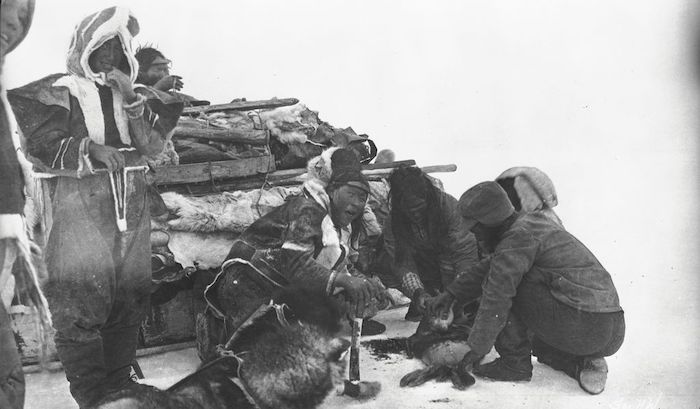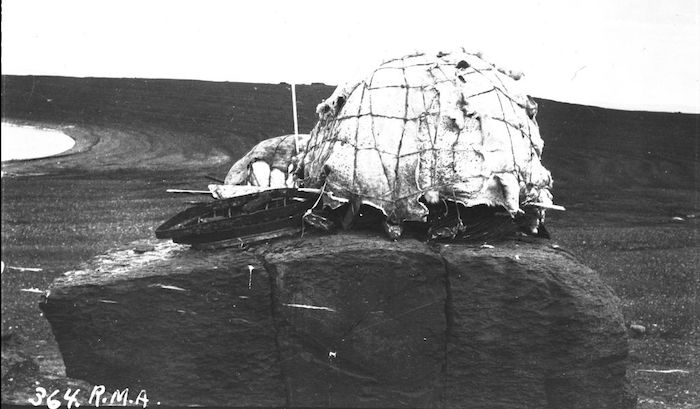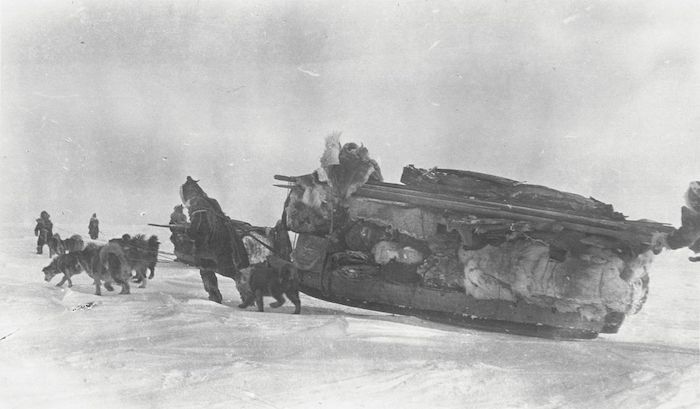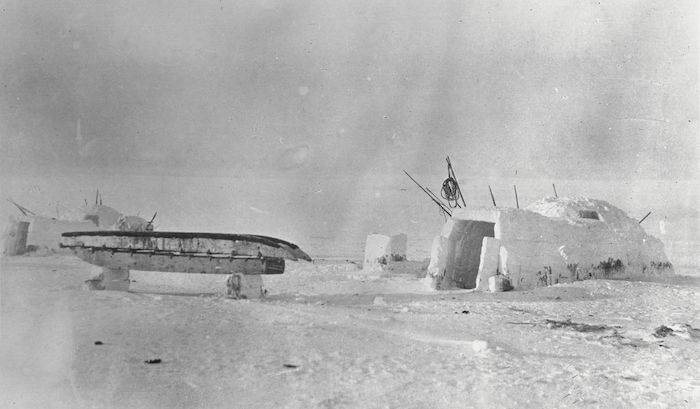Uluksuk Mayuk was an Inuinnait (Copper Inuit) shaman active in the early 1900s. In 1914, he heard about a double murder and went to investigate it. Two years later, a Canadian detective arrived unexpectedly from a world away. Uluksuk and the detective pooled their information and their resources, then Uluksuk led the detective to the crime scene and to the culprit. It’s a remarkable story, and it’s great inspiration for an NPC or an adventure!
This post is brought to you by beloved Patreon backer Arthur Brown. Thanks for helping keep the lights on! If you want to help keep this blog going alongside Arthur, head over to the Patreon page – and thank you!

Image credit: Canadian Museum of History. Released under a CC BY-SA 4.0 license.
Before 1920, the Inuinnait world looked much as it had for centuries. (At least in the big picture. No society is static.) Families wintered on the pack ice of Coronation Gulf north of mainland Nunavut, hunting seals. In summer, they traveled south to meet the caribou on the tundra – but not too far south, since interactions with the northern First Nations were sometimes ugly. A few white explorers and adventurers had passed through, but left no lasting impact. Relations with other Inuit to the west and east were better. While the Inuinnait were ostensibly residents of the Northwest Territories of the Dominion of Canada, the administrative capital at Fort Smith might as well have been on the moon. In the few cases someone traveled that far, the one-way trip usually took over a year. At the dawn of the 20th century, the Inuinnait were utterly separate from the Western world.
Uluksuk Mayuk was a prominent man. He wasn’t a leader – the Inuinnait didn’t have formal leaders at the time – but he was influential. He was also rich. His hut was full of gewgaws he collected and buried in caches when it was time to move. He had three wives, one of whom (Kukiluka) was well-regarded in her own right. Uluksuk was smart and enterprising. He did things for his own well-considered reasons, not because they were expected of him. Given that the closest word to ‘chief’ in Inuinnaqtun means something like ‘thinking man’, it was small wonder he held so much influence. And among the First Nations to the south, he had a fearsome reputation.
Uluksuk was one of Coronation Gulf’s most powerful shamans. He could communicate with the many spirits that fill the world, even the mighty ones that live deep underwater beneath the pack ice. He could take a spirit inside himself to perform remarkable acts. Still today, different shamans have different specialties, and we don’t know Uluksuk’s. Some examples from others include flying, swallowing fire, transforming into animals, killing, raising the dead, predicting the movement of the caribou herds, and replacing diseased body parts with healthy ones.

Image credit: Canadian Museum of History. Released under a CC BY-SA 4.0 license.
In late 1913, with winter approaching, two white men came to live in an Inuinnait camp near Uluksuk’s. They were Catholic missionaries – one French, one Belgian – here to spread the gospel. They spoke not a word of Inuinnaqtun, though one spoke a few words of a related language. No one understood what they were doing here. But one of them was nice enough (the other was a jerk), so everyone made them welcome and gave them pronounceable names: Hogoak and Ilogoak. Uluksuk befriended the two men. He could no more parse their purpose than anyone else, but he was fond of them. When he he headed east to go hunt musk oxen, he promised he’d bring them back some skins to wear over their hilariously inadequate black cassocks.
In the winter of early 1914, Uluksuk returned with the promised skins and learned Hogoak and Ilogoak had been killed. The lead murderer was a known troublemaker named Sinnisiak, and he’d roped in a suggestible accomplice. Those in the camp reported the two strangers had angered a few people. Most folks still liked the strangers, but the two chose to leave. They returned south into the teeth of a deepening winter they probably wouldn’t survive. Two days after Hogoak and Ilogoak left, Sinnisiak and his accomplice departed. They soon returned, announcing they’d killed the strangers. They’d bumped into them on accident in the snow. The priests were armed and angry. Sinnisiak feared for his life, and convinced his accomplice they had to kill the priests before they were killed themselves.
This sat poorly with Uluksuk. The mysterious Hogoak and Ilogoak were his friends. And he didn’t much like Sinnisiak. The murderer had previously threatened to kill Uluksuk! But first there were practical concerns. Uluksuk knew the strangers had left a rifle at their cabin to the south – the place they were fleeing to. The shaman had traded away his own rifle, so he took his family to the cabin to see if the rifle was still there. It was. He also found matches, cartridges, lots of clothing, and some Catholic ritual items (a breviary, two rosaries, etc.). Uluksuk took a particular liking to a black cassock (priest’s robe) and wore it sometimes.
That fall, Uluksuk and his family went looking for the scene of the double killing. They found the priests’ sled. It had been looted, first by the murderers and then by passers-by who weren’t going to let valuable supplies go to waste. They found what was left of Hogoak’s body in a creek and moved it into a deep clay hole. They found Ilogoak’s jawbone and Uluksuk’s father put it on a high place.

Image credit: Canadian Museum of History. Released under a CC BY-SA 4.0 license.
Everything Uluksuk learned from witnesses and from visiting the cabin and the crime scene was confusing. He quite liked the two white men, but no one understood what they were doing so far from home. And how would their murder be addressed? In southern Canada, murder was a crime against the state, so it was the state that sought out and punished murderers. But the Inuinnait had no tradition of state justice; a man’s murder was punished by his family retaliating. Hogoak and Ilogoak had no family near Coronation Gulf, so would their murder go unpunished? Furthermore, Uluksuk had heard from a white adventurer that if one white man were killed, others would come and kill all the Inuinnait. Was that correct? Uluksuk had all the facts of the case, but none of the context he needed to make sense of it. Regardless, he kept tabs on Sinnisiak, the murderer. He noted his comings and goings – just in case.
Coronation Gulf soon had a few white Canadians Uluksuk could talk to about this – except the language barrier proved almost impenetrable. The southern party of the Canadian Arctic Expedition of 1913-1916 had sailed east from the Pacific into Coronation Gulf. Uluksuk repeatedly tried to discuss the murders with its members, but couldn’t make himself understood. In the fall of 1914, he spoke with an explorer, but was able to convey nothing. The same happened later with a zoologist. In September 1915, he spoke with a Mounted Police corporal traveling with the Arctic Expedition. The Mountie had been drawn by reports of Uluksuk wearing a cassock. But Uluksuk was only able to show off some of the Catholic ritual objects (which were part of his gewgaw collection) and convey that he’d gotten them from a white man near a big lake. Two months later, the corporal returned with a half-competent translator from the expedition. The Mountie’s understanding of the resulting interview was bizarre and fragmented. It’s not clear to me whether the translation was bad or whether Uluksuk was obfuscating to forestall a retaliatory expedition aimed at all Inuinnait.

Image credit: Canadian Museum of History. Released under a CC BY-SA 4.0 license.
In May of 1916, another Mountie showed up on Uluksuk’s doorstep. Indian rumors that the two priests had been murdered had reached the Canadian government. Charles LaNauze was tasked with leading a team and making an arrest. It took him and his people a year to travel from Edmonton to Uluksuk’s home. Unlike his predecessors, LaNuze’s team included a competent translator: Ilavinik, an Inuvialuit (Western Canadian Inuit) man with a few years of field translation experience. Inuvialuit is close enough to Uluksuk’s own Inuinnaqtun language that the translator could actually hold a conversation with the shaman.
Uluksuk, LaNauze, and Ilavinik teamed up. The shaman told the Mountie and the translator all he knew – including the probable current location of the murderer Sinnisiak. The Mountie and the translator filled the shaman in on who the priests were and why they’d traveled to Inuinnait lands. They also paid him for his help. The team traveled to a deserted snow village, then tracked its residents to their new location. Uluksuk was confident Sinnisiak was among them. The locals were initially wary. LaNauze feared things might escalate to violence and hid the team’s rifles on their sled so no one would see the weapons and get spooked. As soon as the team got close enough for people to recognize the shaman, things calmed down. The three wandered through the village – and there they found Sinnisiak.
The villagers agreed Sinnisiak needed to go with the Mountie. Uluksuk was probably a big help in swaying their opinion. Remember: Sinnisiak was a habitual troublemaker. The arrival of the shaman and his foreigner friends might be a blessing in disguise if it got rid of Sinnisiak. The murderer was terrified the Mountie was going to kill him (family revenge was the traditional punishment for murder), but under exceptional pressure from everyone around him, he agreed to go.

Image credit: Canadian Museum of History. Released under a CC BY-SA 4.0 license.
Uluksuk led LaNauze’s team elsewhere. He brought them to another village and a hunter who possessed a rifle owned by one of the priests and used in the murder. He separated from the team to take care of some other business, then rejoined them in September to take them to the crime scene. He showed them where the bodies had lain, a fact corroborated by the many bone splinters scattered about where animals had worried the corpses. He showed them the hole where Hogoak’s body lay, still covered by six feet of snow. One of the Mounties turned up Hogoak’s weatherbeaten diary and three empty shell casings that matched the rifle they’d recovered.
Uluksuk’s work on the murder investigation was concluded. He went home. The Mounties rounded up Sinnisiak’s accomplice. They brought both suspects south to Edmonton for trial. The two Inuinnait’s testimonies agreed perfectly: they feared for their lives and killed the priests preemptively. The defense attorney argued this was self-defense. The jury disagreed. It was the first time in Canadian history an Inuit was found guilty of murder. The automatic punishment was death, but the judge got the governor-general to commute that down to a short imprisonment. Uluksuk probably eventually heard some version of this outcome through the grapevine, but we have no way to know for sure.

Image credit: Canadian Museum of History. Released under a CC BY-SA 4.0 license.
At your table, the story of Uluksuk makes wonderful inspiration for a side quest. The PCs witness or hear about some bizarre event or crime. Maybe it grabs their attention enough for them to investigate. Maybe it doesn’t. Either way, while they can gather a lot of mundane details about the case – the who, what, when, and where – nothing they learn makes any sense. It’s clear they’re missing some major piece. Don’t let them linger here and get frustrated. As soon as someone says “I just feel like we’re missing something big,” respond with, “Would you like to do a time jump until a moment where that can be clarified?” If they aren’t curious enough to investigate, don’t worry; it’ll come around again soon.
Then a detective contacts the party. She’s from very far away and she’s very weird: a squid-headed space alien or a bubble of sentient magic or something. She’s come from her distant land on an investigation and has heard the PCs might be able to help her.
It soon becomes clear the detective and the party hold complementary information. The detective knows nothing of the mundane details the PCs can report, but she does possess the why – that missing context that makes everything else make sense. The party and the detective must work together to find any missing puzzle pieces and corner the culprit. (If the PCs didn’t investigate before, now’s their chance!) Because the detective is a big weirdo from far away, she can’t go off and investigate on her own. She doesn’t know the local language, doesn’t know how to avoid getting killed by ordinary things, doesn’t know how to navigate the culture. And if there are any puzzle pieces still missing, the party can’t investigate without the detective, since they might not be able to make sense of what they find.
At my table, I have often had players latch on to an interesting detail and want to learn more. “Man, I wonder what the deal is with those talking crystals.” “Did we ever figure out how the gazebo-man learned all those secrets?” I don’t always know how to steer them towards answers without upending the entire campaign. Uluksuk’s story provides a great template for getting the party the answers they crave while leaving the overall campaign structure intact.

A day I was long dreading arrived about two months ago. Since 2018, I’ve relied on Reddit to bring new eyeballs to the Molten Sulfur Blog. Some months, as much as ninety percent of my traffic has come from links on Reddit! I’ve long been afraid of what will happen should that pipeline of new eyeballs – one totally outside my control – be turned off.
In late August, a post blew up on the biggest RPG-related subreddit complaining about an excess of self-promotion. Opinions in the comments were mixed, but tended to side with the original sentiment: too much spam in our subreddit. The mods reacted in accordance with the wishes of their user community and raised the bar you have to clear to be able to promote yourself on the subreddit. (Caveat: the high bar had been on the books for a while, but the mods stepped up enforcement.) In early October, the mod team decided I don’t clear that bar. With the new, more difficult standard, I’ll still be able to promote these posts on Reddit every so often – but certainly not weekly, the way I’d been doing it since 2018.
This is going to be a sledgehammer to the knee for my web traffic. Fewer eyeballs means fewer people telling their friends about a cool post they read on the blog, which has a cascading effect on readership. Fewer readers means fewer future Patreon backers. It also means that, years from now, when I launch the Kickstarter campaign for Ballad Hunters, fewer people will say “Oh, this is that Molten Sulfur guy. I remember liking his work,” which then means fewer Kickstarter backers.
I write this blog because I enjoy it, not because it turns a profit. I have no plans to stop. But I would very much like to write RPG material full-time someday. Unless I can find a way to replace the Reddit web traffic, this blog is a lot harder to fit into that dream.
If you have any ideas for how to replace the lost Reddit traffic or about anything at all, let me know! To leave a comment below, you need to log in with a Patreon account, but you don’t need to be a Patreon backer. To send an email, go to the top of the page and select ‘contact’ from the menu. Or if you came here from Reddit, you can post there.
Sources:
Bloody Falls of the Coppermine: Madness, Murder, and the Collision of Cultures in the Arctic, 1913 by McKay Jenkins (2005)
The annual Report of the Royal Northwest Mounted Police, 1916. I pulled from two different digitizations: here and here.






